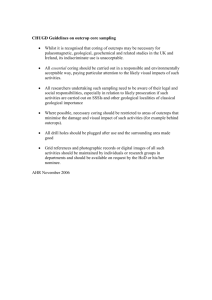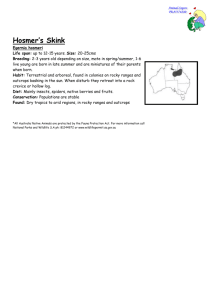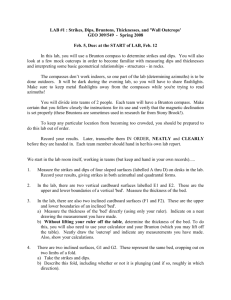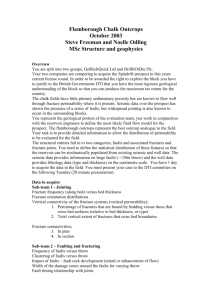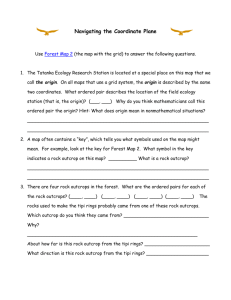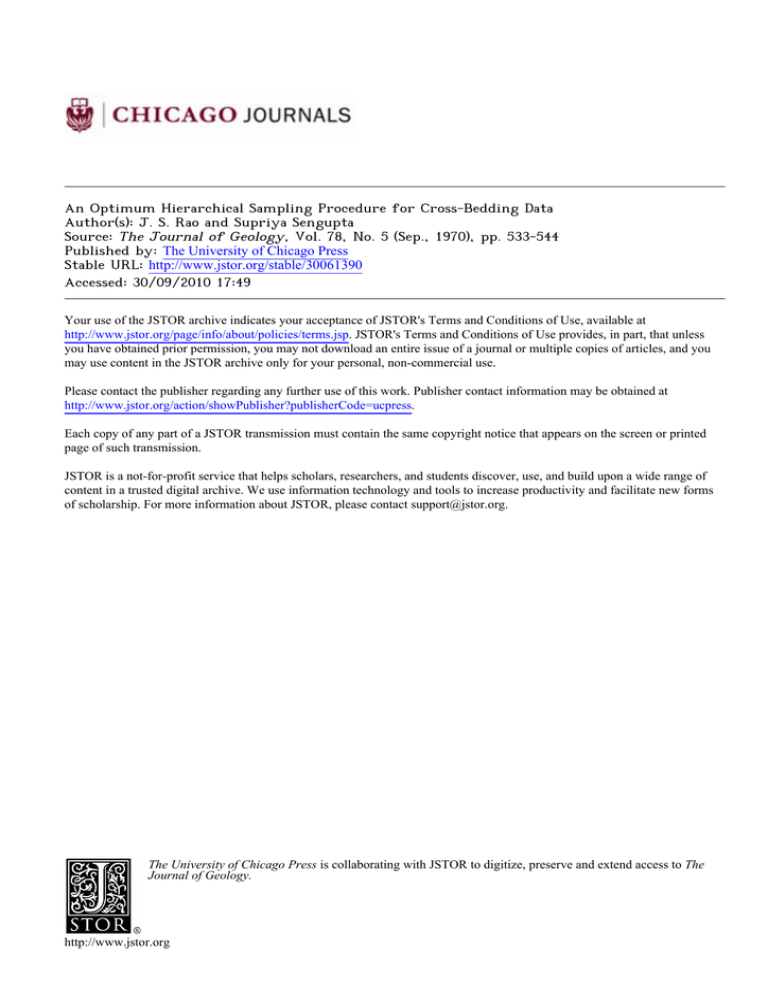
An Optimum Hierarchical Sampling Procedure for Cross-Bedding Data
Author(s): J. S. Rao and Supriya Sengupta
Source: The Journal of Geology, Vol. 78, No. 5 (Sep., 1970), pp. 533-544
Published by: The University of Chicago Press
Stable URL: http://www.jstor.org/stable/30061390
Accessed: 30/09/2010 17:49
Your use of the JSTOR archive indicates your acceptance of JSTOR's Terms and Conditions of Use, available at
http://www.jstor.org/page/info/about/policies/terms.jsp. JSTOR's Terms and Conditions of Use provides, in part, that unless
you have obtained prior permission, you may not download an entire issue of a journal or multiple copies of articles, and you
may use content in the JSTOR archive only for your personal, non-commercial use.
Please contact the publisher regarding any further use of this work. Publisher contact information may be obtained at
http://www.jstor.org/action/showPublisher?publisherCode=ucpress.
Each copy of any part of a JSTOR transmission must contain the same copyright notice that appears on the screen or printed
page of such transmission.
JSTOR is a not-for-profit service that helps scholars, researchers, and students discover, use, and build upon a wide range of
content in a trusted digital archive. We use information technology and tools to increase productivity and facilitate new forms
of scholarship. For more information about JSTOR, please contact support@jstor.org.
The University of Chicago Press is collaborating with JSTOR to digitize, preserve and extend access to The
Journal of Geology.
http://www.jstor.org
AN OPTIMUM
HIERARCHICAL SAMPLING PROCEDURE
FOR CROSS-BEDDING DATA1
J. S. RAO2 AND SUPRIYA SENGUPTA
Indian StatisticalInstitute, Calcutta-35,India
ABSTRACT
The commonlyused techniquesfor hierarchicalor multistagesamplingof cross-bedding
foresetazimuths
(for paleocurrentstudy) are based on the conventionalanalysisof variance.It is now well knownthat the
classicalmethodof analysisof variance(ANOVA),whichpartitionsthe sum of squaresof the observations,
can not be indiscriminatelyappliedfor the analysisof circularlydistributeddirectionaldata. An efficient
and economicalsamplingtechniquefor cross-beddingdata has been developedusing the circularmeasures
of dispersionand the approximateANOVAof Watson.The techniqueis illustratedhere with the help of
the pilot-surveydata of the fluviatileKamthiformation.The followingsamplingproblemshave beensolved:
(1) the minimumsamplesize requiredfor estimating,with a desiredprecision,the meandirectionof a formation, (2) the optimumallocationof the samplesbetweenand within the outcropsthat wouldallow efficient samplingat minimumcost.
within townships and least variation within
cross-bedded units. Potter and Pettijohn
(1963) have also recommended the analysis
of variance (ANOVA) for development of an
efficient sampling plan.
Raup and Miesch (1957) have suggested
a simple field method for determination of
the most efficient and economical sampling
scheme. Their method is based on Stein's
two-stage sampling procedure where the
minimum number of measurements required
to obtain a "significant average" (an average which lies within previously specified
confidence limits) is estimated from the
standard deviation of the first fifty measurements.
It has been stressed by a number of earlier authors (e.g., Watson 1966; Sengupta
and Rao 1966; Rao 1969) that the conventional statistical techniques are of little use
in the analysis of circularly distributed directional data like cross-bedding foreset
azimuths. Although the directions can be
measured as angles with respect to some
arbitrary origin, the arithmetic mean fails
to provide a representative measure of
1Manuscriptreceived December 12, 1969; re- the mean for such data, and the usual
vised February18, 1970.
standard deviation of measurements) using
2 Presentaddress:Departmentof Mathematics, the approximate ANOVA of Watson (1956,
IndianaUniversity,Bloomington,Indiana47401.
method of ANOVA, which partitions the
sums of squares of the observations, can not
OF GEOLOGY,
[JOURNAL
1970, Vol. 78, p. 533-544]
be indiscriminately applied in the analysis
@ 1970. The University of Chicago.All rights reserved.
INTRODUCTION
Cross-bedding foreset dip directions are
known to provide one of the most dependable clues to the paleocurrent. For efficient
and economical sampling of foreset dip directions in a profusely cross-bedded formation, it is essential to know the minimum
number of observations which would give
a mean direction with specified precision
for the whole formation.
An early attempt to provide a suitable,
single stage sampling plan for cross-bedding
was made by Reiche (1938) who suggested
the technique of determination of the "flatness point" in a curve of the "cumulative
vector directions" plotted against the number of measurements. At a later date, Potter
and Olson (Potter and Olson 1954; Olson
and Potter 1954) following a hierarchical
sampling plan, measured the variability associated with different levels of sampling
(between areas, between outcrops, between
beds, and within beds). Their observations
in the Pennsylvanian Mansfield formation
showed largest variation between outcrops
533
534
J. S. RAO AND SUPRIYA SENGUPTA
of circularly distributed directional data.
These facts put into doubt the sampling
plans of the earlierauthors (e.g., Potter and
Olson 1954; Potter and Pettijohn 1963;
Raup and Miesch 1957) which were based
on the conventional ANOVA.
It is now well known that the direction
of sample resultant provides a reasonable
estimate of the population mean direction
for data having unimodal circular distribution, and the length of the resultant can be
used to obtain an appropriate measure of
dispersion.The purposeof the present paper
is to develop an efficientsampling technique
which takes into consideration the circular
measures of dispersion (instead of the usual
standard deviation of measurements) using
the approximateANOVA of Watson (1956,
1966). Admittedly, the methods adopted
here are approximate,but these approximations can be shown to hold good with a fair
degree of accuracy.
Attempts will be made to answer three
major questions in the present paper: (1)
how many observations should be taken
within a geological formation so that the
mean direction is reasonably close to the
true value of the mean, (2) how should the
sampling effort be distributed over two
stages (between outcrops and within outcrops) so that the overall estimate has the
desired precision, and (3) if cost (or time)
considerations could be profitably introduced, what is the procedure which would
minimize the cost (or time) involved. The
questions posed here are the usual questions
faced in sampling and have been handled in
several standard texts on the subject. The
novelty of the present approach lies essentially in the use of the circular measures of
dispersion and the correspondingANOVA
instead of the classical ANOVA based on
variances.
GEOLOGYOF THE AREA AND
THE PILOT SURVEY
The technique of analysis developed here
is illustrated with the help of the data obtained from the Permo-Triassic,fluvial Kamthi formation.Threemembersof the Kamthi
(lower, middle, and upper) were sampled
near Bheemaram,in southeast India for this
purpose. Depositional environments of these
rockshave been discussedin detail elsewhere
(Sengupta 1970). In short, the upper and
the middle Kamthi sandstones representthe
younger and older point-bar and channelbar deposits of the Kamthi river. A part of
the middle Kamthi member also includes
the levee deposits adjacent to the main river
channel. The lower Kamthi sandstones
represent cutoff meander channels within
the older floodplaindeposits of the river. An
earlier statistical analysis of a large sample
of the Kamthi data has indicated that the
population means of the cross-beddings as
well as their dispersionsare significantly different in the three Kamthi members (Sengupta and Rao 1966).
For the purpose of the present work, a
"pilot survey" was conducted and a set of
280 fresh measurementswere taken in about
42 square miles of the Kamthi formation,
following a rigid sampling scheme. A minimum number of widely spaced outcrops
were measuredfrom the three Kamthi members. Although the choice of an outcrop was
partly guided by its accessibility, this was
not allowed to be a significant source of bias
in the analysis. The number of outcrops
measured in each case was broadly proportional to the exposed area of the Kamthi
member concerned.Thus, six outcrops were
measured from the lower Kamthi member
(area: approximately 8 square miles), eight
from the middle Kamthi member (area: approximately 12 square miles), and fourteen
from the upper Kamthi member (area: approximately 22 square miles). A fixed number of ten measurementsof foreset-dipdirections were made in each outcrop by random
sampling.
The model and method of analysis described below give a general idea of the
sampling plan to be adopted under two distinctly different conditions: (1) when the
cross-beddingsare profuse and the foresetdip directions are fairly consistent, as in
the middle and the upper Kamthi, and (2)
when the cross-beddings are less frequent
and the dispersionsare relatively higher, as
in the lower Kamthi.
SAMPLING PROCEDURE FOR CROSS-BEDDING DATA
The method of analysis discussed here
(and illustrated with the Kamthi data) is
of a general nature and can be utilized by
anyone having similar problems involving
circular data.
THE MODEL AND THE METHOD
OF ANALYSIS
We will consider a hierarchical or multistage sampling scheme. For our purposes it
is sufficient to consider a situation with only
two levels, though the results of this and
the next section can easily be extended to
the case where there are more levels of
classification. Suppose, as in the present
case, the first-stage units are called "outcrops" and the second-stage units, "observations." Further, suppose that we have taken
n first-stage units or outcrops and m secondstage units or observations from each of
these first-stage units. It is, however, not
essential to choose the same number of second-stage units from each first-stage unit
though this will considerably simplify the
computations as well as the expressions involved. Let cij denote the jth observation
m; i = 1,
from the ith outcrop (j = 1, ...
.. ., n) of the formation. We assume
#is = 7 + (4 + €~ ,
(1)
where 7 = the mean direction for the formation, (i = deviation due to the ith outcrop from the overall (or formation) mean
direction, and ei = error term. The deviations at each level are supposed to average
out to the mean of the next higher level.
For example, if the number of observations
are increased indefinitely in an outcrop, then
their resultant direction would approach the
particular outcrop mean direction. More
precisely, we assume that within the ith
outcrop, the observations 4i, have a "circular normal distribution" (CND), with mean
direction (7 + (i) and a concentration
parameter 0w.It may be recalled that a random angle 4, with reference to any arbitrary vector in two dimensions, is said to
have a CND with parameters y and K if it
has the density
1
e" (-<>,
O < 4 < 2r.
(2)
535
Here 7 is the population-mean angle and K
is a measure of concentration, larger values
of Kstanding for more concentration around
the mean direction 7. While 4,i's for any
fixed i have a CND with parameters 7 + (,
and w, the (,'s themselves have a CND with
the mean direction as the zero direction and
a concentration parameter, fp. In other
words, the different outcrop means have a
CND whose mean is the formation mean y
and whose concentration parameter is 3. It
may be remarked that most of our analysis
would remain valid even if the assumptions
of circular normality do not hold strictly
for the data in question.
In a particular formation in whose mean
direction we are interested, suppose we visited n outcrops and took m observations from
each of them, thus making a total sample of
size N = mn for the whole forniation. We
then compute the lengths of the resultant
Ri(i = 1, . . . , n) where
R: =
+ (
cos <
sin <~i
(3)
for the n individual outcrops as well as the
length of the overall resultant, R, where
i2
cos
R2 =
i=1
I
j=1
(4)
+
<=
1 sin $ij
based on all the N observations. Now it is
well known (Watson 1966; Rao 1969) that if
R is the length of the resultant based on p
observations from a CND with concentration parameter K, then 2K(p - R) is approximately distributed as a x2 with (p - 1)
degrees of freedom if K is large. Using this
fact, one can have the following approximate ANOVA for the angular data (Watson
1966). Here
n
1
m n - 1 N
1
(5)
in case a variable number of mi observations
are taken from the ith outcrop. This mfis a
J. S. RAO AND SUPRIYA SENGUPTA
536
again have a CND with a concentration
parameter
weighted average of the mi's, and if mi = m
for all outcrops then ii = m.
From table 1 we can test the significance
of between-outcrop variations by using the
F-test
1+
(7)
(n )-' + (N~)-1
These results for the circular (or twodimensional) data are completely analogous
to those of Watson (1966) and Watson and
Irving (1957) for the three-dimensional directions.
(6)
F
which has a F distribution with (n - 1)
and (N - n) degrees of freedom under the
usual ANOVA set up or under the so-called
Model I of ANOVA. Under Model II, the
same technique and computations may be
used to estimate the between-outcrop and
ESTIMATINGTHE FORMATION-MEAN
DIRECTIONWITH A SPECIFIED
PRECISION
Suppose we want to estimate the formation mean 7 with a semiangle of confidence
TABLE 1
ANOVA TABLE FOR ANGULAR DATA
Source of Variation
df
SS
MS
E(MS)
(1)
(2)
(3)
(4)
(5)
Between outcrops
n-1
Within outcrops
N-n
N-
N-1
N-R
Total
(,Ri-R)/(n-
R-R
_R
within-outcropconcentrations-0 and co,respectively-under the assumptions we have
made in the beginning of this section. If the
test in (6) shows no significantvariation between the sites (or outcrops), then the between-outcrop variation may be ignored or,
in other words, the concentrationparameter
B may be taken to be infinity. If, on the
other hand, the F-test gives a significant result, then the estimates of f and w, say f
and co, may be obtained by equating the
mean squares (MS) in column 4 of table 1
with the correspondingexpectations in column 5.
Now if all the N = mn observations are
used to get the overall resultant and its direction iN is used to estimate the mean
direction of the formation, then this will
1)
(N- ZRi)/(N-n)
a)
^1
,lo at a confidencelevel 1 - a, (0 < a < 1).
That is, if VN denotes the direction of the
overall resultant based on N observations,
we want the estimate 7N to lie within the
interval 7 -
/o to 7 + Lo in (1 - a) per-
cent of the cases. This would clearly depend
on the distribution of TN, which from the
earlier section is circular normal with concentration given by (7). Thus the concentration parameter Kassociated with the distribution of iN would determine the confidence interval for 7. But since in our case
the problem is one of finding the sample
size required in order to have a confidence
interval of specified width and confidence
level, we try to determine a value of K,say
KO,requiredfor 7j to lie in the specified interval with the given probability. Thus we
SAMPLING PROCEDURE FOR CROSS-BEDDING DATA
must first answer the question: How large
should Kbe such that a semiangle of confidence #o around y carries a probability of
(1 - a) percent? If Kwere less than 7, one
can refer to Watson's (1966) chart and read
out the required K.But this range of Kvalues
is too small to be of use in most practical
situations of our interest where the Kvalues
often exceed 100. For such large values of K,
the following normal approximation to the
CND can profitably be used. If 4 is a random angle having a CND with parameters
7 and K, then it is known that the distribu-
537
standard normal distribution (e.g., Xa =
1.96 for a = 5 percent). Comparing (8) and
(9), VKo#o = Xaor
KO =
Xe
Po
(10)
We give a short table of values of Ko
(table 2) required to attain some commonly
specified precisions as given by /o and a.
Thus if tN is to attain the given precision,
the number of outcrops n and the number
of observations in each, namely, m, should
TABLE 2
VALUE
OF Ko REQUIRED
FOR YN TO
ATTAIN A GIVEN PRECISION
fo
Semiangle
dence
KO
(1-a)
of
Confi-
50
100
200
Confidence
Level
Concentration
Value Required
0.90
354.6292
0.95
0.99
504.0610
870.6882
0.90
88.7598
0.95
0.99
126.1125
217.9236
0.90
0.95
0.99
22.1772
31.5221
54.4496
tion of 4* = /K (4 - y) approaches a
standard normal distribution for large K.
Therefore, for given a(0 < a < 1), we want
a Kfor which
be such as to give a K value as shown in
table 2. In other words, from (7) m and n
should be such as to satisfy the equation
1
(1 - a) = P, (7 - P(-V/
to <
Ko
< V
7 +
0o)
o(KO )_, + (m )-1"
(qS- y)
(8)
< V/ ro)
= P(1*1 <V ' o).
But since 4* is distributed as N(0, 1), we
have
P(| ** < xi) = (1 -
)o
(9)
where X, is the a percent point for the
(11)
in order that the overall resultant direction
have a specified accuracy, where Ko is determined by #koand a and is obtained from
table 2. The equation (11) still does not completely specify what m and n should be.
Several sets of m and n values are possible,
of which we may choose one depending on
the convenience and availability of outcrops. For example, if a maximum number
538
J. S. RAO AND SUPRIYA SENGUPTA
of only no outcrops are available, then one
can obtain the value of m from (11) as
m
(.l---
=
C = Co + n(Ci + mC2)
= Co + Ko(\ +
1
(C1 + mC2)
)
-
= terms not containing m
If, on the other hand, a large number of outcrops are available and one wants to take
only one observation per outcrop (i.e.,
m = 1), then we need to visit
n
=
1 1
-
K
( Cx
mC,\
,
+ --)
which when minimized with respect to m
gives
1\
+ -J
cls
mz
outcrops. Between these two extremes, one
has several choices for m and n, all of which
lead to the same precision for the overall
resultant direction.
We will now introduce cost considerations into the picture and then try to arrive at an optimum choice of m and n, that
is, a choice which minimizes the total cost
of the operation. We generally have a rough
idea as to the cost (or time) involved in
visiting an outcrop and in taking a single
observation. Let C1 be the cost involved in
reaching the outcrop (location, identification, and transportationcosts) and C2be the
cost of making an observation within the
outcrop. Then the total cost involved in the
operation may be expressed as
C = Co + nC1+ nmC2,
.•
C2iL)
m
or
=
(15)
)
Thus the optimum number of observations
that should be taken from each outcrop is
given by (15). Substituting this in (13), we
get the correspondingvalue of n, the optimum number of outcrops. If m and n are
chosen this way, the minimum cost associated with this operation (or survey)
would be
Cmin = Co + KO(1+
•
-C
(16)
(12)
where Co is the total overheadcost. Now we
might ask for a choice of m and n, which,
besides assuring us of a specified precision,
minimizes the cost involved in the entire
operation. It may be remarked that we do
not need to have a precise idea about the
costs C1 and C2. What is needed for our
purposesis only a rough idea about the relative costs, or the ratio Ci/C2.
It is clear from (7) that the number of
outcrops, n, way be expressed as
n = Ko6+
+
(14)
(13)
Substituting this in the cost function (12),
we have
The optimum value of m given in (15) can
also be found graphically by plotting the
cost (14) as a function of m. Such graphs
can be made for several choices of C1/C2
and /^/.
The expressions for the optimum values
of m and n, say m* and n*, would, in general, contain a fractional part, in which case
it may be rounded off to the next higher integer so that the final estimate would be
at least as accurate as required. In fact, if
this is done and, say, mo and no are the optimum values so arrived at, then 'N will
have a precision parameter
K
1
(not)_ + (monoc)_
(17)
SAMPLING PROCEDURE FOR CROSS-BEDDING DATA
and hence the semiangle of confidence for
YNwill be
=
(18)
.
We illustrate these ideas and methods in
the following section by applying them to a
specific situation.
539
observations from each. The ANOVA table
for these Nu = 140 observations belonging
to the UK is given below. The data and the
details of computation are not presented for
reasons of brevity. The overall resultant
based on all the 140 observations is Ru =
(82.5159, -22.5615), with a length Ru =
x/(82.5159)2 + (-22.5615)2 = 85.5447. The
sum of the lengths of individual resultants is
ANALYSIS OF KAMTHIPOPULATIONS
14
Rwu = 91.8074.
Earlier studies (Sengupta and Rao 1966)
i=-1
have shown that the cross-beddingforesetdip directions of the three Kamthi members From this, we form the ANOVA table for
belong to three significantly different popu- the UK data (see table 3). The value of the
lations. Thus we have a simple hierarchical F-statistic, 1.2593, is insignificant at the 5
TABLE 3
ANOVATABLEFORUK DATA
Source
df
SS
MS
E(MS)
F
F=1.2593
Between outcrops
13
6.2627
0.4817
1(1
10\
2\wu +' 3u
Within outcrops
126
48.1926
0.3825
1
2wv
139
54.4553
Total
classification within each Kamthi member
with two levels of sampling in each, namely,
outcrops and observations.
As mentioned in the beginning, for the
present analysis a total of twenty-eight outcrops were sampled, out of which fourteen
are from the upper Kamthi (UK), eight from
the middle Kamthi (MK), and the rest
from the lower Kamthi (LK). From each
outcrop we have taken a total of ten observations at random though, as we remarked
earlier, it is not essential to have the same
number of observationswithin each outcrop.
However this will facilitate computations.
We shall first deal with the UK, and the
analysis of the other two populations proceeds on exactly similar lines. We shall use
the subscript U to denote the quantities
corresponding to the UK population. We
then have nv = 14 outcrops with my = 10
percent level with 13 and 126 degrees of
freedom, the tabulated critical value being
1.83.3 Thus the variation between outcrops
is not significant in the UK population and
hence i, the measure of concentration between UK outcrop means, may be taken to
be infinity. In other words, all the UK outcrops may be taken to have the same mean
direction which is also the UK formationmean direction. If /3 = o,
then estimate
of w, say c&r,may be obtained by pooling
the between and within the sum of the
squares and the degrees of freedom. This
gives cg = 2.5526.
Also equation (7) for Kreduces to
K=
NW .
(19)
Therefore, the number of observations N
* This situation needs special treatment not discussed earlier.
J. S. RAO AND SUPRIYA SENGUPTA
540
which one should take in order to attain a
semiangle of say 100 with 95 percent confidence (which correspondsto a value of KO=
126.1125 from table 2) is
*
n
126.1125(5
1O)
50.4032 + 26.1440/ (24)
1
= 7.3258,
or roughly 7.4 Thus in UK if one takes
outcrops and twenty observations
seven
49.40, (20)
U
from each, this would, besides giving us
or roughly fifty observations. Thus, in the the required accuracy, also minimize the
UK, one can estimate the formation-mean overall cost of estimating the formadirection to within +100 with 95 percent tion mean. In fact, if we took seven outconfidenceon the basis of fifty observations. crops and twenty observations from each,
However, the evidence for accepting the the accuracy parameter K for the overall
hypothesis / = oois not strong, the F-value resultant direction is, from (17), KU= 7/
+ [20(1.3072)]-1} = 120.5033,
being not too small. Therefore, one may {(50.4032)-'
and hence the estimated mean direction has
take into account the between-outcropvarithe semiangle of confidence
Ko
N =
126.1125
2.5526
ation also, in which case we follow the procedure as outlined in the earlier section. We
find the estimates, f and c, by equating columns 4 and 5 of table 3, and we get
Wu = 1.3072 and vu = 50.4032
nu
,
or
(22)
nv = 126.1125 [(50.4032)-1
+ (mu 1.3072)-1].
Throughout our present study we assume
a cost ratio of Ci/C2 = 10/1, which seems
to be reasonable in our case. Now appealing to (15), the optimum number of observations, say m*, to be taken within each
UK outcrop is given by
m
= < CaC
C2~
-
110 X 50.4032
1 X 1.3072
1.96
V120.5033
(25)
= 0.1785 radians,
or 100 13' with 95 percent confidence.
Similar analysis can be done for the other
two Kamthi populations. For the eight outcrops of the MK with ten observations from
each; we have ANOVA table 4. For 7 and
72 df, the F-value of 4.5660 is quite significant even at 1 percent level, the tabulated
value being 2.14, and therefore the several
site (outcrop) means differ significantly in
the MK. Our model is thus more appropriate in this situation. Equating columns 4
and 5 of table 4, we get the estimates / and
for the MK, namely,
WM= 2.0000, and d/M= 5.6085.
(23)
or roughly twenty observations from each
outcrop. Substituting this value of m*j = 20
(26)
Now if we are to estimate the overall mean
direction with a semiangle of ± 100 with 95
percent confidenceas in the earliercase, the
nM and mM should satisfy the equation
126.1125 =
nM
()-1
= 19.6,
in (22),
Xo.os
VKU-
(21)
for the UK formation. If we now wish to
estimate the formation mean with + 100 accuracy with 95 percent confidence (which
corresponds to a Kvalue of 126.1125), the
values m and n should satisfy the equation
(7), that is,
126.1125 =
u
+
(mM
or
nuM= 126.1125 [(5.6085)-1
.M)-1
(27)
+ (mM 2.0000)-1.
4 Earlier we suggested rounding off such fractions
to the next higher integer. But this need not be fol-
541
SAMPLING PROCEDURE FOR CROSS-BEDDING DATA
But from equation (16) and an assumed
cost ratio of 10/1, the optimum number of
observations to be taken in a MK outcrop is
m =
/10 X 5.6085
1X 2.0000= 5.295, (28)
or roughly 6. Now from (27) the number of
outcrops to be visited in the MK is
n* = 126.1125
M
5.6085
12000
12.0000
Finally for the six outcrops of the LK,
where again we have taken ten observations
in each, we have the ANOVA shown in
table 5. Here again the F-value is significant
at 5 percent level with 5 and 54 df, the tabulated value being 2.40. Thus the site (outcrop) means in LK do vary significantly.
Therefore, equating columns 4 and 5 of
table 5, we have
(29)
(29)
= 32.99,
or roughly 33. Thus for minimizing the cost
of the operation, we need to take thirty-
<oL= 1.3154, and 1L = 6.1058.
(31)
If we wish to estimate the LK formation
mean by means of the direction of the overall resultant, again with an accuracy of
TABLE 4
ANOVA TABLE FOR MK DATA
df
Source
Betweenoutcrops
Withinoutcrops
Total
7
7.9907
1.1415
72
17.9985
0.2500
79
25.982
three outcrops in the MK but only six observations from each. This larger number
of outcrops is a consequence of the fact
that in MK the between-outcrop variation is very significant. This scheme of visiting thirty-three outcrops and taking six
observations from each would give an accuracy parameter of KM= 33/[(5.6085)-1 +
(6 X 2.0000)-1] = 126.1303 for the resultant based on 33 X 6 = 198 MK observations. The MK mean can be estimated with
a semiangle of
S
M=
MS
SS
126.1303
F
-
F=4.5660
2M
+ 100 with 95 percent confidence, then the
nL and mL should satisfy the equation
126.1125 =
n
( L)-1 + (mLL)-1
or
(32)
nL = 126.1125 [(6.1058)-1
+ (mL 1.3154)-1].
But the equation (16) involving costs tells
us that
S=
1.96
E(MS)
m*I
O/10X
6.1058
1 X 1.3154 =6.8125,
(33)
(30)
= 0.1745 radians,
or 100 with 95 percent confidence.
lowedas a hardand fast rule since that wouldoften
increasethe sample size and we would have much
moreprecisionthan we askedfor.
or roughly seven observations should be
taken from each LK outcrop. Substituting
this value of mL = 7 in (32),
,* =121
1
= 126.1125[ 6.1058
= 34.35 ,
7(1.3154)
1
542
J. S. RAO AND SUPRIYA SENGUPTA
or roughly 34. Thus we should sample
thirty-four outcrops in the LK taking seven
observations from each which leads to an
accuracy parameter of
ber of observations required for estimation,
with a desired precision, of mean direction
which will be reasonably close to the true
value of the formation mean; and (2) the
pattern of distribution of the samples be34
tween and within the outcrops that would
K"= (6.1058)-i + [7(1.3154)]-1
allow sampling with optimum efficiencyand
at minimum cost.
= 124.8246
The techniques used here in finding anfor the distribution of the overall resultant swers to these questions can be summarized
direction. Then this sample mean direction as follows:
1. To start with, a small number of reprebased on 34 X 7 = 238 observations would
be within PL = 1.96//124.8246
= 0.1754
sentative cross-bedding samples are obradians, or 10°3' of the true LK formation tained (a more or less uniformly spaced grid
mean with 95 percent confidence.
sample) for the population (formation) unTABLE 5
ANOVATABLEFORLK DATA
Source
Betweenoutcrops
Withinoutcrops
Total
df
SS
E(MS)
MS
5
5.9950
1.1990
54
20.5235
0.3801
59
26.5185
SUM.MARY AND CONCLUSIONS
The techniques so far used for sampling
and analysis of cross-bedding data were
based on the conventional ANOVA. It is
now well known that for the circularly distributed directional data (like cross-bedding
foreset azimuths) the technique of ANOVA
is of little use. For such data, the direction
of the sample resultant (instead of the
arithmetic mean) provides a reasonable estimate of the population mean, and the length
of the resultant (instead of the standard deviation) provides an approximate measure
of dispersion.
An efficient and economical sampling
technique for cross-bedding directions has
been developed in the present work using
the circular measures of dispersion. With
the help of the pilot-survey data of the fluviatile Kamthi formation, it has been attempted to find out: (1) the minimum num-
F
+
F=--3.1544
2W.
der study. Observations from each outcrop
within the population are recorded separately. Equal number of observations from each
outcrop facilitates computations, although
this is not an essential requirement.
2. Sine and cosine values are computed
for each foreset-dip direction (0) measured.
The resultant direction for each outcrop is
computed as in equation (3), that is,
R. =
=
cos <)
Co +
+
E sin 0,)
s,
where Ri is the outcrop resultant for the ith
outcrop and m = number of observations
within each outcrop.
3. The overall resultant for all the outcrops is now computed as in (4), that is,
=
i=l
/
+
i
SAMPLING PROCEDURE FOR CROSS-BEDDING DATA
where n = number of outcrops surveyed
and C and Si are as in step 2 above, that is,
and
Ci = E cos 4,i,
i-1
Si = C sin 4ii.
i-1
4. The appropriate values are now filled
in table 1.
5. The values for concentration within
outcrop (co) and concentration between outcrops (B) are obtained by equating columns
4 and 5 of table 1.
6. The optimum number of observations
543
ability is smallest in case of the upper Kamthi member where the sediments were deposited as point bars and channel bars of
a river, apparently having a fairly consistent
direction of sediment transport. The situation requires sampling of only a few outcrops and collection of a comparatively
greater number of observations within each
outcrop-an easy plan to follow in the field.
The large, between-outcrop variation in
lower Kamthi demands measurement of a
large number of outcrops. The lenses of
cross-bedded sandstones measured in the
lower Kamthi are interpreted as remnants
of cut-off meander channels caught up with-
TABLE 6
SCHEME OF SAMPLING OF KAMTHI CROSS-BEDDING DATA
Formation Member
No. ObservaNo. Outcrops tions Required
within Each
to be
Sampled (n*)
Outcrop
Total No
Observations
(m*)
Upper Kamthi
Middle Kamthi
Lower Kamthi
to be taken in an outcrop, m*, is obtained
from equation (15), that is,
m* =
C*^lf3
C2<0'
where C1 and C2 are the costs for reaching
an outcrop and taking an observation within
an outcrop, respectively.
7. The optimum number of outcrops to
be sampled, n*, is obtained from equation
(13), where Ko, the concentration for a desired confidence level (1 - a) and the semiangle of confidence, (/o), is obtained from
table 2.
This technique of analysis suggests the
scheme of sampling for the Kamthi formation members as shown in table 6.
This shows that between-outcrop vari-
7
33
34
20
6
7
140
198
238
in the flood basin deposits-a pattern which
can be expected to have little consistency.
The large between-outcrop variation in
middle Kamthi is presumably related to the
fact that a part of this member represents
irregularly deposited levees adjacent to the
main river channel.
ACKNOWLEDGMENTS:-We
are grateful to
Professor P. C. Mahalanobis and Dr. C. R. Rao
of the Indian Statistical Institute for taking
active interest in the statistical analysis of circular data and for their encouragement and
helpful advice. This work is the result of a
collaboration between a statistician and a
geologist and is a contribution to the program
of study of the Gondwana deposits of the
Pranhita-Godavari Valley, undertaken by the
Geological Studies Unit of the Indian Statistical
Institute at the initiative of Dr. P. L. Robinson.
544
J. S. RAO AND SUPRIYA SENGUPTA
REFERENCES CITED
BATSCHELET,E., 1965, Statistical methods for the
analysis of problems in animal orientation and
certain biological rhythms: Am. Inst. Biol. Sci.
Mon. 57 p.
OLSON,J. S., and POTTER,P. E., 1954, Variance
components of cross-bedding direction in some
basal Pennsylvanian sandstones of the Eastern
Interior basins: statistical methods: Jour. Geology, v. 62, p. 26-48.
P. E., and OLSON,J. S., 1954, Variance comPOTTER,
ponents of cross-bedding direction in some basal
Pennsylvanian sandstones of the Eastern Interior
basins: geological application: Jour. Geology, v.
62, p. 50-73.
----,
and PETTIJOHN,F. J., 1963, Paleocurrents and basin analysis: Berlin, Springer-Verlag,
296 p.
RAo, J. S., 1969, Some contributions to the analysis
of circular data: Unpub. Ph.D. thesis, Indian
Statistical Inst., Calcutta.
RAUP,O. B., and MIESCH,A. T., 1957, A new method for obtaining significant average directional
measurements in cross-stratification studies:
Jour. Sed. Petrology, v. 27, p. 313-321.
REICHE,P., 1938, An analysis of cross-lamination:
the Coconino sandstone: Jour. Geology, v. 46,
p. 905-932.
SENGUPTA,S., 1970, Gondwana sedimentation
around Bheemaram (Bhimaram), PranhitaGodavari Valley, India: Jour. Sed. Petrology,
v. 40, p. 140-170.
---,
and RAO, J. S., 1966, Statistical analysis of cross-bedding azimuths from the Kamthi
formation around Bheemaram, Pranhita-Godavari Valley, Sankhy.: Indian Jour. Statistics,
ser. B, v. 28, pts. 1, 2, p. 165-174.
WATSON,G. S., 1956, Analysis of dispersion on a
sphere: Royal Astron. Soc. Monthly Notices
Geophys. Supp., v. 7, p. 153-159.
1966, The statistics of orientation data:
--Jour. Geology, v. 74, p. 786-797.
---,
and IRVING,E., 1957, Statistical methods
in rock magnetism: Royal Astron. Soc. Monthly
Notices Geophys. Supp., v. 7, p. 289-300.

